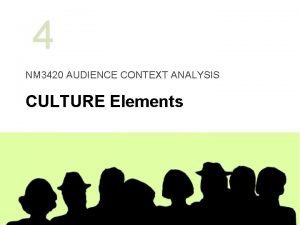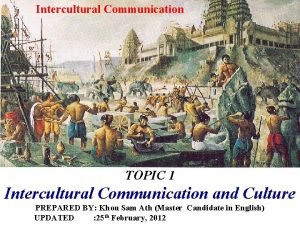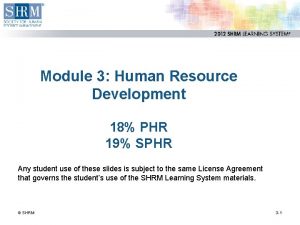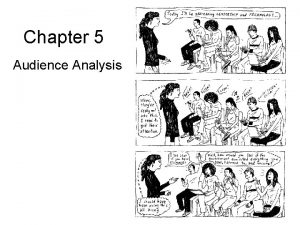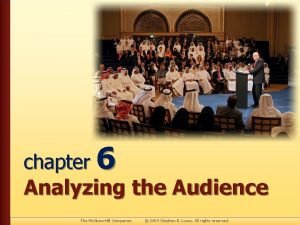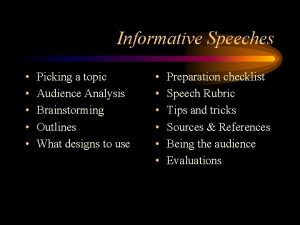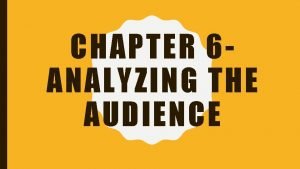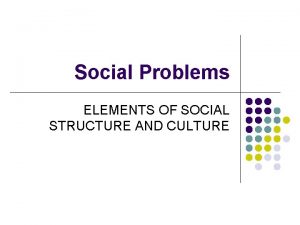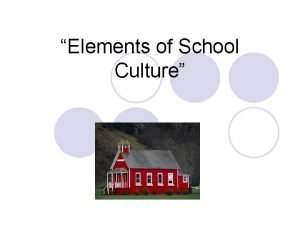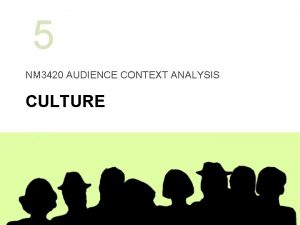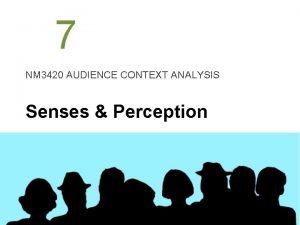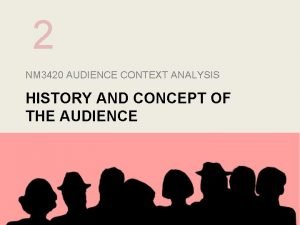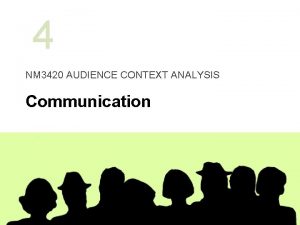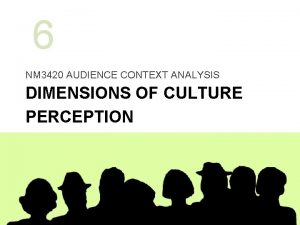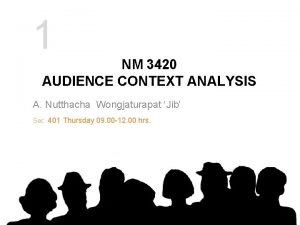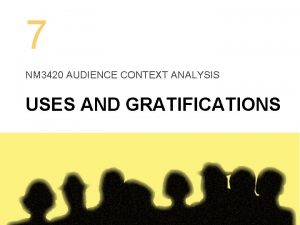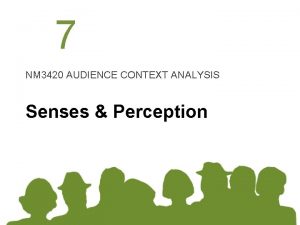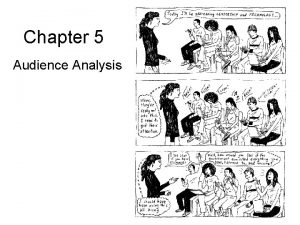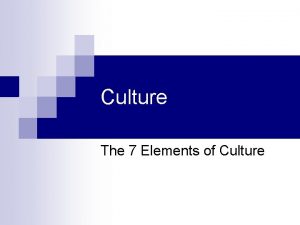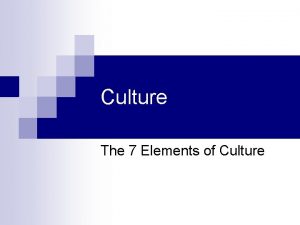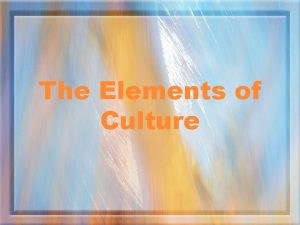4 NM 3420 AUDIENCE CONTEXT ANALYSIS CULTURE Elements
















![Analyzing information - Noticing details: Pay attention to the details] - Linking facts - Analyzing information - Noticing details: Pay attention to the details] - Linking facts -](https://slidetodoc.com/presentation_image_h/afe48b61262fb9873016fa4f0e9d81aa/image-17.jpg)


































- Slides: 51

4 NM 3420 AUDIENCE CONTEXT ANALYSIS CULTURE Elements

Last Week Highlight HISTORY OF EARLY AUDIENCES Time change Media change Audience change

Today. . . Sampling Culture Sampling methods - Globalization 1. - Definition of culture - Elements of culture - Western and Eastern 2. 3. Person-to-person interview Telephone interview Mail-administered survey perspectives of Methodologies communication Question Errors - High context vs Low context culture

Water Do you think different brands target different audiences? How?

Water Target differently - Appeal to different group(s) of people - Your target would prefer your product than others Mass Everyone / Anyone

Do Not Jump to conclusion so quickly! What Evidence? Stat? Pictures? Books? Articles? Survey? Interview? Youtube VDO? Google? Ads? Official website? Company’s vision? Financial statements? Campaigns? ANYTHING!

Water 100% Natural Mineral Water 100% natural mineral water with the proper amount of vital minerals for healthcertified by CARSO –LSEHL laboratory, France for daily drinking & baby’s health and appealing, practical packaging, taste and convenience The cycle of mineral water in Popra. Mont Fleur water, nature’s element, travels up to the earth’s surfacethrough mineral -rich capillaries from a depth of over 10, 000 ft. It reaches the top and springs out in the warm steamy form with perfect mineral balance CARSO-LABORATOIRE

Water

Water

Why care about targeting audience? Media - Target so that you Know your audience! This is NM class!!! >>> Help your Design >>> Help select the right media channel >>>WTF Create? ? impact !!!!! >>> Convey the right meaning! This For ? ? !!!!) >>>(What’s Better communication >>> Avoid miscommunication AND SO MUCH MORE. .

Let’s guess the price ($) Fine – $5 per 750 ml Bling H 2 O – $40 per 750 ml 10 Thousand BC – $14 per 750 ml

Acqua di Cristallo Tributo a Modigliani $60, 000 per 750 ml


Sampling Methods of identify and measure audience Different types of sampling methods Ways to understand your audience Definition Population: A group of individual who may have an opinion relating to the subject of the survey (Miller, 1995) Impossible to communicate with everyone Sample: Selected individuals from the population as representatives

Sampling Methods We will be focusing on focus group method 1. Person-to-person interview (BEST) 2. Telephone interview 3. Mail-administered survey

Measurement Errors In reality >> There are complex mathematical equations when collecting samples 1. Too small samples 2. Researchers try to measure complex concept through questionnaires
![Analyzing information Noticing details Pay attention to the details Linking facts Analyzing information - Noticing details: Pay attention to the details] - Linking facts -](https://slidetodoc.com/presentation_image_h/afe48b61262fb9873016fa4f0e9d81aa/image-17.jpg)
Analyzing information - Noticing details: Pay attention to the details] - Linking facts - Linking events - Understanding individuals as well as the contexts - Know the world

Audience Research Methodologies • Survey • Interview • Test • Observation

Question Errors Avoid Leading questions Leading the interviewees to some certain answer “You are 2 years old and your brother is half of your age now, Today you are 100 years old, how old is your brother? ” “What do you think about the benefits of. . . ? ”

Question Errors Avoid double-barreled questions Two separated topics in one question How happy are you with your phone company’s rate and customer service?

Examples of questions Imagine that you are the owner of the radio company and your target is running away from you because time changes, You want to know them as they are today in order to create new strategy to keep them. Open- ended Question Don’t Ask ABOUT your own radio channel You want to know their current behavior Discuss. .

Culture - Globalization - Definition of culture - Elements of culture - Western and Eastern perspectives of communication - High context vs Low context culture

NM 3420 AUDIENCE CONTEXT ANALYSIS CULTURE Globalization Are we all the same? Do we enjoy the same thing?

NM 3420 AUDIENCE CONTEXT ANALYSIS CULTURE Globalization What the World Thinks Country Spread of U. S. Ideas a “Good Thing” (%) Like U. S. Music, Movies, TV (%) Like U. S. Science and Technology (%) Canada 37 76 77 Britain 39 76 77 Russia 16 42 41 Mexico 22 60 69 South Korea 30 53 81 South Africa 43 71 79 Turkey 11 44 67 Egypt 6 33 51 Jordan 13 30 59 Pakistan 2 4 42 SOURCE: Pew Research Center for the People and the Press, “What the World Thinks in 2002, ” posted on the Pew Website: http: //www. people-press. org.

NM 3420 AUDIENCE CONTEXT ANALYSIS CULTURE Culture definition What is Culture?

NM 3420 AUDIENCE CONTEXT ANALYSIS CULTURE Culture definition Nineteenth Century In the 19 th century, the term culture was commonly used as a synonym for Western civilization. Sir Edward B. Tylor (1871) popularized the idea that all societies pass through developmental stages, beginning with “savagery, ” progressing to “barbarism, ” and culminating in Western “civilization. ”

NM 3420 AUDIENCE CONTEXT ANALYSIS CULTURE Culture definition Today’s definition • A community or population sufficiently large enough to be selfsustaining, that is, large enough to produce new generations of members without relying on outside people. • The totality of that group’s thought, experiences, and patterns of behavior and its concepts, values, and assumptions about life that guide behavior and how those evolve with contact with other cultures. • The process of social transmission of thoughts and behaviors from birth in the family and schools over the course of generations. • Members who consciously identify themselves with that group.

NM 3420 AUDIENCE CONTEXT ANALYSIS CULTURE Elements of culture

NM 3420 AUDIENCE CONTEXT ANALYSIS CULTURE Elements of culture Hofstede (1994) 1. Symbols 2. Rituals 3. Values 4. Heroes

NM 3420 AUDIENCE CONTEXT ANALYSIS CULTURE Elements of culture Hofstede (1994) 1. Symbols Verbal and nonverbal language 2. Rituals 3. Values 4. Heroes

NM 3420 AUDIENCE CONTEXT ANALYSIS CULTURE Elements of culture Hofstede (1994) 1. Symbols 2. Rituals The socially essential collective activities within a culture 3. Values 4. Heroes

NM 3420 AUDIENCE CONTEXT ANALYSIS CULTURE Elements of culture Hofstede (1994) 1. Symbols 2. Rituals The feelings not open for discussion 3. Values within a culture about what is good or bad, beautiful or ugly, normal or 4. Heroes abnormal, which are present in a majority of the members of a culture

NM 3420 AUDIENCE CONTEXT ANALYSIS CULTURE Elements of culture Hofstede (1994) 1. Symbols 2. Rituals The feelings not open for discussion 3. Values within a culture about what is good or bad, beautiful or ugly, normal or 4. Heroes abnormal, which are present in a majority of the members of a culture

NM 3420 AUDIENCE CONTEXT ANALYSIS CULTURE Elements of culture

NM 3420 AUDIENCE CONTEXT ANALYSIS CULTURE Elements of culture Hofstede (1994) 1. Symbols 2. Rituals Discussion Question: 3. Values Who are heroes in your culture? 4. Heroes The real or imagery people who serve as behavior models within a culture.

NM 3420 AUDIENCE CONTEXT ANALYSIS CULTURE Elements of culture Hofstede (1994) 1. Symbols 2. Rituals Discussion Question: 3. Values Who are heroes in your culture? 4. Heroes The real or imagery people who serve as behavior models within a culture.

NM 3420 AUDIENCE CONTEXT ANALYSIS CULTURE Superstitions Discussion Question: Give examples of superstitions in your culture?

NM 3420 AUDIENCE CONTEXT ANALYSIS CULTURE East VS West Eastern and Western perspectives

NM 3420 AUDIENCE CONTEXT ANALYSIS CULTURE HIGH CONTEXT vs LOW CONTEXT culture

NM 3420 AUDIENCE CONTEXT ANALYSIS CULTURE High versus Low Context Level of Context, by culture High Low China Switzerland Japan Germany Korea North American Indian Nordic states Most Latin American cultures Southern and eastern Mediterranean

NM 3420 AUDIENCE CONTEXT ANALYSIS CULTURE High versus Low Context High-context cultures make greater distinction between the insiders and outsiders than lowcontext cultures do. People raised in high-context systems expect more of others than do the participants in low-context systems. When talking something they have on their minds, a high-context individual will expect his interlocutor to know what’s bothering him, so that he does not have to be specific. The result is that he will talk around the point, in effect putting all the pieces in place except the crucial one. Placing it properly – this keystone – is the role of his interlocutor. - E. T. Hall, Beyond Culture (1976, p. 98)

NM 3420 AUDIENCE CONTEXT ANALYSIS CULTURE

NM 3420 AUDIENCE CONTEXT ANALYSIS CULTURE

NM 3420 AUDIENCE CONTEXT ANALYSIS CULTURE

NM 3420 AUDIENCE CONTEXT ANALYSIS CULTURE

NM 3420 AUDIENCE CONTEXT ANALYSIS CULTURE

NM 3420 AUDIENCE CONTEXT ANALYSIS CULTURE

NM 3420 AUDIENCE CONTEXT ANALYSIS CULTURE

NM 3420 AUDIENCE CONTEXT ANALYSIS CULTURE

NM 3420 AUDIENCE CONTEXT ANALYSIS CULTURE

NM 3420 AUDIENCE CONTEXT ANALYSIS CULTURE Reference: Jandt, Fred E. An Introduction to Intercultural Communication: Identities in a Global Community. Thousand Oaks, CA: Sage, 2010.
 Ceng 3420
Ceng 3420 Purpose audience context culture
Purpose audience context culture High context vs low context culture ppt
High context vs low context culture ppt Communicating across generational differences
Communicating across generational differences Invoked audience
Invoked audience Situational writing
Situational writing Presupposition triggers
Presupposition triggers Soal essay komunikasi nonverbal
Soal essay komunikasi nonverbal Low context culture examples
Low context culture examples Intercultural communication meaning
Intercultural communication meaning High context culture
High context culture Low context culture examples
Low context culture examples Low context culture
Low context culture High context culture
High context culture Material culture examples
Material culture examples Sociologists define a symbol as
Sociologists define a symbol as Batch culture vs continuous culture
Batch culture vs continuous culture Fed-batch
Fed-batch Characteristics of collectivism
Characteristics of collectivism American vs indian culture
American vs indian culture Stroke culture method
Stroke culture method Folk culture and popular culture venn diagram
Folk culture and popular culture venn diagram What is a subculture
What is a subculture Chapter 4 folk and popular culture
Chapter 4 folk and popular culture Anaerobic medium
Anaerobic medium Folk culture and popular culture venn diagram
Folk culture and popular culture venn diagram In an inert organizational culture,
In an inert organizational culture, Pour plate method
Pour plate method Lawn culture
Lawn culture Quality culture changing hearts minds and attitudes
Quality culture changing hearts minds and attitudes Surface culture deep culture and esol
Surface culture deep culture and esol N communication
N communication Elements of communication context
Elements of communication context Steps of audience analysis
Steps of audience analysis Purpose of a memo
Purpose of a memo Audience analysis example
Audience analysis example Informal audience
Informal audience Situational audience analysis definition
Situational audience analysis definition Why is it important to analyze your audience
Why is it important to analyze your audience Multicultural audience analysis
Multicultural audience analysis Audience analysis in technical communication
Audience analysis in technical communication Situational audience analysis
Situational audience analysis Situational audience analysis example
Situational audience analysis example Audience analysis for informative speech
Audience analysis for informative speech What does being audience-centered involve
What does being audience-centered involve Public speaking is more highly structured
Public speaking is more highly structured Explain market analysis
Explain market analysis 8 elements of culture
8 elements of culture Basic elements of culture
Basic elements of culture 7 element of culture
7 element of culture Dear diary about school
Dear diary about school Importance of culture in international business
Importance of culture in international business

